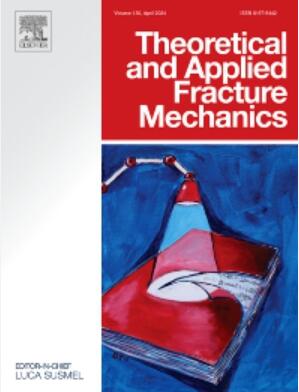A new mixed mode I/II fracture test specimen considering the influence of cracks and holes
IF 5.6
2区 工程技术
Q1 ENGINEERING, MECHANICAL
引用次数: 0
Abstract
This study presents a novel testing specimen for mixed-mode I/II fracture characterization in cracked-perforated materials commonly found in pipelines and tunnels. The improved semi-circular bend (ISCB) specimen incorporates a semi-ring geometry with a centrally located hole and prefabricated radial crack, enabling accurate simulation of crack-hole interactions under structural loading conditions. Through finite element analysis, we systematically quantified critical fracture parameters including mode I/II stress intensity factors and T-stress. Experimentally, three-point bending tests on PMMA ISCB specimens using a universal testing machine quantified crack initiation angles and fracture toughness values. Comparative analyses of classical fracture criteria revealed the generalized maximum tangential stress (GMTS) criterion’s superior predictive capability. The GMTS criterion achieved the most accurate fracture angle predictions with <5 % deviation in average fracture toughness estimates.
一种考虑裂纹和孔洞影响的新型混合I/II型断裂试件
本研究提出了一种新的测试样品,用于管道和隧道中常见的裂纹穿孔材料的混合模式I/II断裂表征。改进的半圆弯曲(ISCB)试件结合了半环形几何形状,中间有一个孔和预制的径向裂缝,能够精确模拟结构加载条件下的裂缝-孔相互作用。通过有限元分析,系统量化了I/II型应力强度因子和t应力等关键断裂参数。实验上,采用万能试验机对PMMA ISCB试件进行三点弯曲试验,量化了裂纹起裂角和断裂韧性值。与经典断裂准则的对比分析表明广义最大切向应力(GMTS)准则具有较好的预测能力。GMTS准则实现了最准确的断裂角预测,平均断裂韧性估计偏差为<; 5%。
本文章由计算机程序翻译,如有差异,请以英文原文为准。
求助全文
约1分钟内获得全文
求助全文
来源期刊

Theoretical and Applied Fracture Mechanics
工程技术-工程:机械
CiteScore
8.40
自引率
18.90%
发文量
435
审稿时长
37 days
期刊介绍:
Theoretical and Applied Fracture Mechanics'' aims & scopes have been re-designed to cover both the theoretical, applied, and numerical aspects associated with those cracking related phenomena taking place, at a micro-, meso-, and macroscopic level, in materials/components/structures of any kind.
The journal aims to cover the cracking/mechanical behaviour of materials/components/structures in those situations involving both time-independent and time-dependent system of external forces/moments (such as, for instance, quasi-static, impulsive, impact, blasting, creep, contact, and fatigue loading). Since, under the above circumstances, the mechanical behaviour of cracked materials/components/structures is also affected by the environmental conditions, the journal would consider also those theoretical/experimental research works investigating the effect of external variables such as, for instance, the effect of corrosive environments as well as of high/low-temperature.
 求助内容:
求助内容: 应助结果提醒方式:
应助结果提醒方式:


